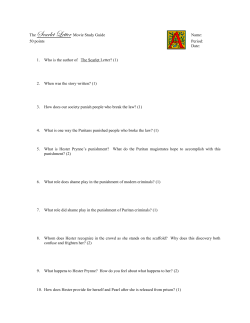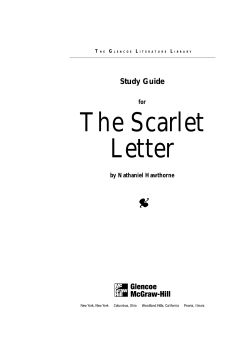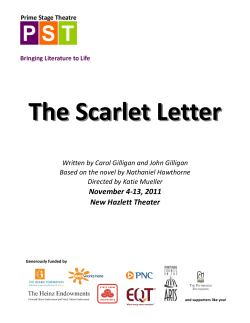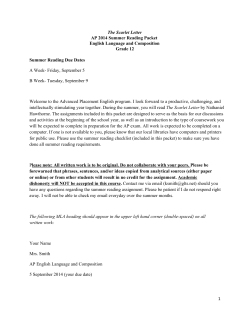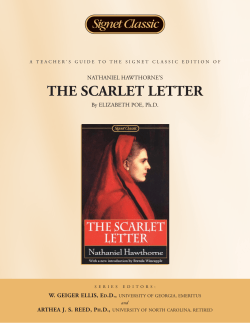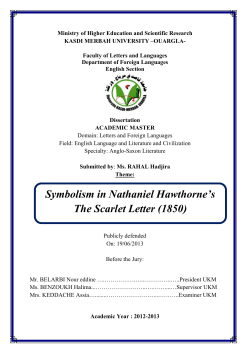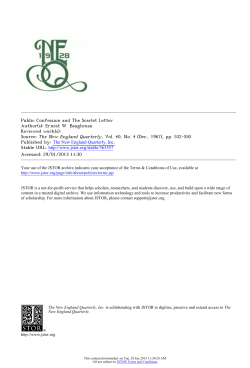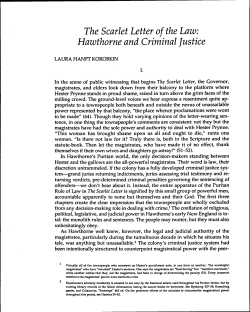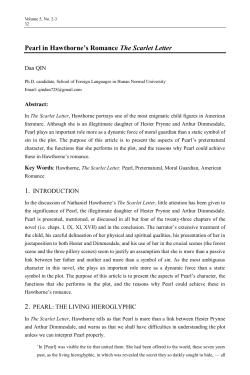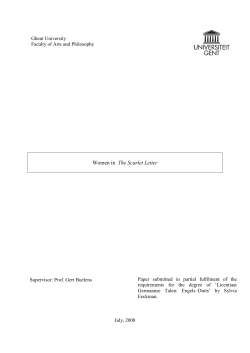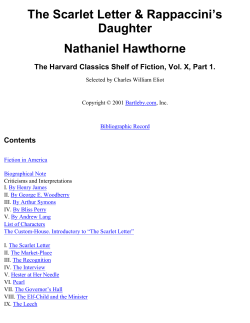
THE SCARLET LETTER
UNIT: THE SCARLET LETTER ANCHOR TEXT UNIT FOCUS The Scarlet Letter, Nathaniel Hawthorne (Literary) Students explore the role and impact religion had on the establishment of the American colonies and its continued influence throughout the formation of the American identity. Foundational literary works, speeches, and documents illustrate the nature of religious influence on periods in US history. Other informational texts provide students the opportunity to discuss the nature of religious influence in modern America. RELATED TEXTS Literary Texts • “The Minister’s Black Veil,” Nathaniel Hawthorne • “The Devil and Tom Walker,” Washington Irving • “The Hollow Men,” T. S. Eliot Informational Texts • Paragraphs 21-27, 29-30, 38-39, and 44 from “Sinners in the Hands of an Angry God,” Jonathan Edwards • “How Religion in the United States Avails Itself of Democratic Tendencies” from Democracy in America, Alexis de Tocqueville • John Brown’s Speech to the Court at His Trial, John Brown • Second Inaugural Address, Abraham Lincoln • The Virginia Act for Establishing Religious Freedom, Thomas Jefferson • Wisconsin v. Yoder (No. 70-110), Supreme Court of the United States • December 23, 1776, entry from The Crisis, No. 1, Thomas Paine • Last two paragraphs from “A Model of Christian Charity,” John Winthrop Nonprint Texts (Fiction or Nonfiction) (e.g., Media, Video, Film, Music, Art, Graphics) • Gallup Poll Results on Religion • “Americans Say More Religion in US Would Be Positive” from Gallup, Frank Newport (Video) English Language Arts, Grade 11: The Scarlet Letter Text Use: Examine foundational literary works, speeches, and documents; build historical knowledge Reading: RL.11-12.1, RL.11-12.2, RL.11-12.3, RL.11-12.4, RL.11-12.5, RL.11-12.6, RL.11-12.9, RL.11-12.10, RI.11-12.1, RI.11-12.2, RI.11-12.3, RI.11-12.4, RI.11-12.5, RI.11-12.6, RI.11-12.7, RI.11-12.8, RI.11-12.9, RI.11-12.10 Writing: W.11-12.1a-e, W.11-12.2a-f, W.11-12.4, W.11-12.5, W.11-12.6, W.11-12.7, W.11-12.8, W.11-12.9a-b, W.11-12.10 Speaking and Listening: SL.11-12.1a-d, SL.11-12.2, SL.11-12.3, SL.11-12.4, SL.11-12.6 Language: L.11-12.1a-b, L.11-12.2a-b, L.11-12.3a, L.11-12.4a-d, L.11-12.5a-b, L.1112.6 CONTENTS Page 277: Text Set and Unit Focus Page 278: The Scarlet Letter Unit Overview Page 279-281: Summative Unit Assessments: Culminating Writing Task, Cold-Read Task, and Extension Task Pages 282: Instructional Framework Pages 283-300: Text Sequence and Sample Whole-Class Tasks 277 The Scarlet Letter Unit Overview Unit Focus • • • Topic: Religious influence in the United States Themes: The role and impact religion had on the establishment of the American colonies and its continued influence throughout the formation of the American identity Text Use: Examine foundational literary works, speeches, and documents; build historical knowledge Summative Unit Assessments A culminating writing task: • • Analyze the impact of an author’s choices on the development of meaning in a text Write a literary analysis A cold-read task: • • • Read and understand complex informational texts Compare how different texts treat similar ideas or concepts Write in response to texts An extension task: • • Conduct topical research about a self-generated question Write a multipage report Daily Tasks Daily instruction helps students read and understand text and express that understanding. • • • • • • • • • • • • English Language Arts, Grade 11: The Scarlet Letter Lesson 1: “Sinners in the Hands of an Angry God” and “The Minister’s Black Veil” (sample tasks) Lesson 2: Introduction and Chapters 1-2 from The Scarlet Letter, “How Religion in the United States Avails Itself of Democratic Tendencies” from Democracy in America (sample tasks) Lesson 3: Chapters 3-8 from The Scarlet Letter (sample tasks) Lesson 4: Chapters 9-12 from The Scarlet Letter Lesson 5: Chapters 13-14 from The Scarlet Letter and John Brown’s Speech to the Court at His Trial (sample tasks) Lesson 6: Chapters 15- 16 from The Scarlet Letter and “The Devil and Tom Walker” (sample tasks) Lesson 7: Chapters 17-20 from The Scarlet Letter (sample tasks) Lesson 8: Chapters 21-24 from The Scarlet Letter and Second Inaugural Address (sample tasks) Lesson 9: The Scarlet Letter (culminating writing task) Lesson 10: The Virginia Act for Establishing Religious Freedom, Wisconsin v. Yoder (No. 70-110), “Americans Say More Religion in U.S. Would Be Positive,” Gallup poll results on religion, and “The Hollow Men” (sample tasks) Lesson 11: Various texts for independent research (extension task) Lesson 12: Excerpt from “A Model of Christian Charity” and excerpt from The Crisis, No. 1 (cold-read task) 278 SUMMATIVE UNIT ASSESSMENTS CULMINATING WRITING TASK 1 The Scarlet Letter contains a number of significant symbols. Write a literary analysis that examines how Hawthorne’s choices in character development, setting development, and the structure of events contribute to the development of two central ideas of The Scarlet Letter. (RL.11-12.2, RL.11-12.3, RL.11-12.5) In the analysis, focus on how word choice, tone, and symbolism contribute to the development of characters, setting, and events of the novel. (RL.11-12.4, L.11-12.5ab) Provide strong and thorough textual evidence that is integrated while maintaining the flow of ideas and including proper citation. (RL.11-12.1, W.11-12.1a-e, W.11-12.8, W.11-12.10, L.11-12.1, L.11-12.2a-b) Teacher Note: Students should write a literary analysis that examines how word choice, tone, and symbolism help to structure and develop the characters, setting, and events, thus revealing the central ideas of The Scarlet Letter. Students must establish and develop claims with relevant evidence and create cohesion and style by using grade-appropriate words, phrases, and varied syntax. (W.11-12.4, W.11-12.9a, W.11-12.10, L.11-12.3a, L.11-12.6) The completed writing should demonstrate command of conventions of grammar, usage, punctuation, and spelling. (L.11-12.1, L.11-12.2a-b) Use peer and teacher conferencing as well as small-group writing time to target student weaknesses in writing and improve student writing ability. (W.11-12.5) UNIT FOCUS What should students learn from the texts? • Topic: Religious influence in the United States • Themes: The role and impact religion had on the establishment of the American colonies and its continued influence throughout the formation of the American identity • Text Use: Examine foundational literary works, speeches, and documents; build historical knowledge 1 UNIT ASSESSMENT DAILY TASKS What shows students have learned it? This task assesses: Which tasks help students learn it? Read and understand text: • • • • • • • Analyzing the impact of an author’s choices on the development of meaning in a text Writing a literary analysis Lesson 2 (sample tasks included) Lesson 3 (sample tasks included) Lesson 5 (sample tasks included) Lesson 6 (sample tasks included) Lesson 8 (sample tasks included) Express understanding of text: • • • • Lesson 1 (sample tasks included) Lesson 4 Lesson 7 (sample tasks included) Lesson 9 (use this task) Culminating Writing Task: Students express their final understanding of the anchor text and demonstrate meeting the expectations of the standards through a written essay. English Language Arts, Grade 11: The Scarlet Letter 279 COLD-READ TASK 2 Read the December 23, 1776, entry from The Crisis, No. 1 by Thomas Paine and the last two paragraphs from “A Model of Christian Charity” by John Winthrop independently. (RI.11-12.10) Then answer a combination of multiple-choice and constructed-response questions 3 about the text, using evidence for all answers. Sample questions: 1. What is the impact of Paine’s use of literary devices (e.g., allusion, hyperbole, analogy, etc.) in The Crisis, No. 1? Explain how these devices strengthen the persuasiveness of the text. (RI.11-12.1, RI.11-12.3, RI.11-12.4, RI.11-12.6, W.11-12.9b, W.11-12.10) 2. Review the following words from The Crisis, No. 1: impious, infidel, penitentially, solemnize, hypocrisy, ardor. Select one of the words and define it in context and explain how it is used in the sentence. (RI.11-12.4, L.11-12.4a, L.11-12.4b) 3. Compare and contrast the ideas set forth by Paine and Winthrop. (RI.11-12.9) Explain how Paine draws on ideas set forth by Winthrop to develop an effective argument, including the use of religious connotations, imagery, and allusions. (RI.11-12.5, W.11-12.2a-f, W.11-12.4, W.11-12.9b, W.11-12.10, L.11-12.2a-b, L.11-12.3a, L.11-12.5b, L.11-12.6) 4. Reread this quotation from Winthrop: “For we must consider that we shall be as a city upon a hill. The eyes of all people are upon us. So that if we shall deal falsely with our God in this work we have undertaken, and so cause Him to withdraw His present help from us, we shall be made a story and a byword through the world.” Write an essay examining how Winthrop’s warning is expressed through one or more characters or events in The Scarlet Letter. (RL.11-12.9, RI.11-12.1, W.11-12.1a-e, W.11-12.4, W.11-12.9a-b, W.11-12.10, L.11-12.2a-b, L.11-12.3a, L.11-12.6) UNIT FOCUS What should students learn from the texts? • Topic: Religious influence in the United States • Themes: The role and impact religion had on the establishment of the American colonies and its continued influence throughout the formation of the American identity • Text Use: Examine foundational literary works, speeches, and documents; build historical knowledge UNIT ASSESSMENT DAILY TASKS What shows students have learned it? This task focuses on: Which tasks help students learn it? Read and understand text: • • • • • • • Reading and understanding complex informational texts Comparing how different texts treat similar ideas or concepts Writing in response to texts Lesson 2 (sample tasks included) Lesson 8 (sample tasks included) Lesson 10 (sample tasks included) Lesson 11 (sample tasks included) Express understanding of text: • • Lesson 1 (sample tasks included) Lesson 12 (use this task) 2 Cold-Read Task: Students read a text or texts independently and answer a series of multiple-choice and constructed-response questions. While the text(s) relate to the unit focus, the text(s) have not been taught during the unit. Additional assessment guidance is available at http://www.louisianabelieves.com/resources/classroom-support-toolbox/teacher-support-toolbox/end-of-yearassessments. 3 Ensure that students have access to the complete texts as they are testing. English Language Arts, Grade 11: The Scarlet Letter 280 EXTENSION TASK4 The First Amendment of the Constitution of the United States (the “Free Exercise Clause”) guarantees freedom of religion, speech, press, petition, and assembly. Investigate the challenges to and limits of the amendment in regard to religion. 1. Select a topic that examines the role of religion in America (e.g., Supreme Court cases over religious matters, separation of church and state, role of religion in historical events, religious cults, or history of various religions). 2. Research a self-generated question. Gather multiple digital and print resources, assessing their usefulness and synthesizing information to demonstrate an understanding of the chosen topic. (W.11-12.7, W.11-12.8) 3. Write a research-based, multipage report that first explains the topic and then defends or disputes the importance of the First Amendment of the Constitution of the United States. (RI.11-12.1, W.11-12.1a-e, W.11-12.2a-f, W.11-12.9b, W.11-12.10) 4. Be sure to incorporate quotations from multiple sources while maintaining the flow of ideas and. Use Supreme Court rulings as models for the structure, development, language, and style of the argument. (W.11-12.4, W.11-12.8, L.11-12.1, L.11-12.2a-b, L.11-12.3a) UNIT FOCUS What should students learn from the texts? • Topic: Religious influence in the United States • Themes: The role and impact religion had on the establishment of the American colonies and its continued influence throughout the formation of the American identity • Text Use: Examine foundational literary works, speeches, and documents; build historical knowledge 4 UNIT ASSESSMENT DAILY TASKS What shows students have learned it? This task focuses on: Which tasks help students learn it? Read and understand text: • • • Conducting topical research about a selfgenerated question Writing a multi-page report Lesson 10 (sample tasks included) Express understanding of text: • • • Lesson 1 (sample tasks included) Lesson 11 (sample tasks included) Lesson 12 (use this task) Extension Task: Students connect and extend their knowledge learned through texts in the unit to engage in research or writing. The research extension task extends the concepts studied in the set so students can gain more information about concepts or topics that interest them. The writing extension task either connects several of the texts together or is a narrative task related to the unit focus. English Language Arts, Grade 11: The Scarlet Letter 281 INSTRUCTIONAL FRAMEWORK In English language arts (ELA), students must learn to read, understand, and write and speak about grade-level texts independently. To do this, teachers must select appropriate texts and use those texts so students meet the standards, as demonstrated through ongoing assessments. To support students in developing independence with reading and communicating about complex texts, teachers should incorporate the following interconnected components into their instruction. Click here 5 to locate additional information about this interactive framework. Whole-Class Instruction This time is for grade-level instruction. Regardless of a student’s reading level, exposure to grade-level texts supports language and comprehension development necessary for continual reading growth. This plan presents sample whole-class tasks to represent how standards might be met at this grade level. Small-Group Reading This time is for supporting student needs that cannot be met during whole-class instruction. Teachers might provide: 1. intervention for students below grade level using texts at their reading level; 2. instruction for different learners using grade-level texts to support whole-class instruction; 3. extension for advanced readers using challenging texts. Small-Group Writing Most writing instruction is likely to occur during whole-class time. This time is for supporting student needs that cannot be met during whole-class instruction. Teachers might provide: 1. intervention for students below grade level; 2. instruction for different learners to support whole-class instruction and meet grade-level writing standards; 3. extension for advanced writers. Independent Reading This time is for increasing the volume and range of reading that cannot be achieved through other instruction but is necessary for student growth. Teachers can: 1. support growing reading ability by allowing students to read books at their reading level; 2. encourage reading enjoyment and build reading stamina and perseverance by allowing students to select their own texts in addition to teacher-selected texts. 5 http://www.louisianabelieves.com/resources/classroom-support-toolbox/teacher-support-toolbox/lesson-assessment-planning-resources English Language Arts, Grade 11: The Scarlet Letter 282 TEXT SEQUENCE AND SAMPLE WHOLE-CLASS TASKS TEXT SEQUENCE LESSON 1:6 Paragraphs 21-27, 29-30, 38-39, and 44 from “Sinners in the Hands of an Angry God,” Jonathan Edwards “The Minister’s Black Veil,” Nathaniel Hawthorne TEXT USE TEXT DESCRIPTION: Jonathan Edwards’s speech describes the sinful nature of his congregation in attempt to convince them to change their ways. “The Minister’s Black Veil” is a parable that illustrates sin and hypocrisy. TEXT FOCUS: The excerpt from the sermon by Edwards uses rhetoric to elicit an emotional response. (RI.11-12.6) “The Minister’s Black Veil” contains symbolism and foreshadowing, which help to develop Parson Hooper’s character. (RL.11-12.3) Despite different methodology, both pieces provide insight into the Puritanical ideals upon which the United States was founded. (RL.11-12.9, RI.11-12.9) These texts can be useful for examining word choice, point of view, imagery, and rhetorical devices as tools to develop central ideas. MODEL TASKS LESSON OVERVIEW: Students listen to the speech and read the short story independently. Then students analyze the language and devices of each text. Finally, students compare and contrast the writing style of each author. READ AND UNDERSTAND THE TEXT: • Edwards’s piece is a sermon, read the excerpts aloud as students follow along with a copy. (RI.11-12.10) • Divide students into pairs. With their partner, have students rewrite a passage from Edwards’s sermon, replacing any use of “you.” 7 Then discuss as a class how the changes they made affect the impact of the text: What is the significance of using the second person point of view? How does this contribute to the persuasiveness of the sermon? (RI.11-12.5, RI.11-12.6) • Have students reread paragraph 24, focusing on Edwards’s language choices: How does Edwards use willingly throughout the paragraph? What is the rhetorical significance of this word? How does the repetition of it convey meaning and/or purpose? (L.11-12.5b) • Have pairs create a three-column chart: (1) Record examples of images, analogies, hyperboles, and strong word choices from the sermon, (2) paraphrase the examples and interpret their meaning, and (3) explain the rhetorical purpose of the devices and how they develop a tone and central idea of the sermon. (RI.11-12.2, RI.11-12.3, RI.11-12.4, RI.11-12.6, L.11-12.5a) 6 Note: One lesson does not equal one day. Teachers should determine how long to take on a given lesson. This will depend on each unique class. For example: “The Use may be of Awakening to unconverted Persons in this Congregation. This that you have heard is the Case of every one of you that are out of Christ. That World of Misery, that Lake of burning Brimstone is extended abroad under you. There is the dreadful Pit of the glowing Flames of the Wrath of God; there is Hell’s wide gaping Mouth open; and you have nothing to stand upon, not any Thing to take hold of: there is nothing between you and Hell but the Air; ’tis only the Power and meer Pleasure of God that holds you up.” 7 English Language Arts, Grade 11: The Scarlet Letter 283 TEXT SEQUENCE • TEXT USE Have students read “The Minister’s Black Veil” independently. (RL.11-12.10) • Have students create a second three-column chart independently: (1) Record images and symbols in the short story, (2) paraphrase the examples and interpret their meaning, and (3) explain the significance of the examples and how they contribute to development of characters, setting, or a theme in “The Minister’s Black Veil.” (RL.11-12.2, RL.11-12.3, L.11-12.5a) • Place the students into pairs to compare and contrast both charts and, using their answers as a starting point, determine the central ideas communicated by the Edwards and Hawthorne, and explain how those ideas are developed through the choices each author makes in the texts. (RL.11-12.2, RL.11-12.9, RI.11-12.2, RI.11-12.9, SL.11-12.1a) Monitor the discussion of each pair to ensure they are asking quality questions and referring to the texts as the basis of their discussion. (SL.11-12.1c-d) As pairs need support analyzing the texts, use these prompts: o Analyze how each author introduces and develops his central ideas throughout each text. (RL.11-12.2, RI.11-12.2) o Analyze the style of both Edwards and Hawthorne. Focus on imagery, point of view, rhetorical devices, and word choice. (RL.11-12.4, RI.11-12.4, RI.11-12.6, L.11-12.3a, L.11-12.5, SL.11-12.1, SL.11-12.3) o Compare Parson Hooper with Jonathan Edwards. Both are representative of Puritanical ministers, yet their approaches with their congregations are very different. What language, details, or elements in each text most contribute to their different styles and impact? (SL.11-12.3) EXPRESS UNDERSTANDING: • Have students write a timed literary analysis in response to the following prompt: Compare and contrast the meaning and style of “Sinners in the Hands of an Angry God” and “The Minister’s Black Veil.” How does each author convey his meaning to the readers? Which author’s style is more effective and why? (RL.11-12.2, RL.1112.9, RI.11-12.2, RI.11-12.9, W.11-12.1a-e, W.11-12.4, W.11-12.9a-b, W.11-12.10) • When students are finished writing, have them swap their essay with a peer, who will review the written response for the following: 1. Identify and underline the thesis or main claim of the essay. 2. Next to each body paragraph, write a one-sentence summary. (RI.11-12.2) Determine how the ideas of the body paragraph are connected to the main claim of the essay. Next to the thesis statement, write a brief summary describing the organization and connection between various ideas of the essay. English Language Arts, Grade 11: The Scarlet Letter 284 TEXT SEQUENCE TEXT USE 3. Underneath each summary sentence, list the evidence used in that paragraph (e.g., direct quotation, paraphrased quotation, key details from the text). (RI.11-12.1) 4. Assess the quality of the evidence and how well it supports the thesis and ideas of the paragraph. Place a plus sign next to relevant evidence and logical reasoning and a minus sign next to irrelevant evidence or false reasoning. 5. Review the sentence structure and offer suggestions for increasing the complexity by adding more phrases and clauses or varying syntax. (L.11-12.1, L.11-12.3a) 6. Circle strong vocabulary words in the text and note any unnecessary repetitions. (L.11-12.6) 7. Edit the essay for spelling mistakes and use of proper punctuation. (L.11-12.2a-b) • LESSON 2: Introduction: “The Custom-House” and Chapters 1-2 from The Scarlet Letter, Nathaniel Hawthorne “How Religion in the United States Avails Itself of Democratic Tendencies” from Democracy in America, Alexis de Tocqueville Return the essays to their owners and have students review the feedback. Allow students to rewrite their essays, revising sentences and strengthening their arguments based on the feedback. (W.11-12.4, W.11-12.5) TEXT DESCRIPTION: The introduction provides a frame for the novel. The novel begins with a description of the prison in which Hester and Pearl reside and continues to show the public humiliation required as part of Hester’s punishment. This is paired with a text that examines how religion and democracy are intertwined in America. TEXT FOCUS: This portion of the text connects to the previous texts in that Puritanical values are present. In addition, the interdependence of religion and government are evident (e.g., Hester is in prison for sinning). There is also a connection between the two texts, as Hawthorne provides some commentary on hypocrisy. Tocqueville describes the importance of a general conception of God and responsibility to fellow man and says that matters that are not essential aspects of religion are to be left to majority rule. MODEL TASKS LESSON OVERVIEW: Students read the introduction and beginning chapters of The Scarlet Letter independently. Then they reread the introduction and the excerpt from Democracy in America in pairs. They analyze both texts and examine the correlation between the four texts they’ve read in the unit so far. Students then write an essay about the narrative structure of The Scarlet Letter. READ AND UNDERSTAND THE TEXT: • Have students read the portion of The Scarlet Letter independently. This can be done outside of class and discussed in class. (RL.11-12.10) • While students read The Scarlet Letter, have them do the following: English Language Arts, Grade 11: The Scarlet Letter 285 TEXT SEQUENCE o • • o Summarize the setting, characters, and events of the first two chapters. (RL.11-12.2) o Record examples of symbolism in a three-column graphic organizer: (1) List the symbols found in The Scarlet Letter, (2) provide proper citation information (page number, paragraph number, etc.), and (3) describe the meaning of the symbols in The Scarlet Letter. Students will continue to use the graphic organizer throughout the unit. (RL.11-12.1, RL.11-12.4, L.11-12.5a-b) During class, have students read the excerpt from Democracy in America in pairs. (RI.11-12.10) Have pairs outline Tocqueville’s argument, focusing on the following questions: (RI.11-12.8, RI.11-12.9) o Identify two to three central ideas being discussed. What is Tocqueville’s stated purpose? o Next to each paragraph, paraphrase or summarize the content. (RI.11-12.2) o How do the central ideas interact over the course of the text? Identify three quotations from the text that support this intersection and the relationship between the ideas. (RI.11-12.1, RI.11-12.2, RI.1112.3) o Explain the structure of Tocqueville’s argument based on how each paragraph relates. Does the structure support his argument and make it more clear, convincing, or engaging? (RI.11-12.5) o How does Tocqueville appeal to his audience to convince them of his purpose? (RI.11-12.6) Conduct a discussion in which students are prompted to synthesize information from each of the four texts read thus far. (RL.11-12.9, RI.11-12.9, SL.11-12.1a-d, SL.11-12.4, SL.11-12.6) Prompt students to use accountable talk8 and cite textual evidence throughout the discussion. (RL.11-12.1, RI.11-12.1) Possible discussion questions: o 8 TEXT USE Identify unknown vocabulary (e.g., edifice, physiognomies, antinomian, magistrate, malefactresses, sumptuary, evanescent, ignominy, iniquity, contumely, phantasmagoric, remonstrance) and sentences with complicated, unusual, or interesting syntax. Explain the meaning of the words, how they are used in context (i.e., determine the part of speech based on its affix or placement in the sentence), and verify the meaning and part of speech in a dictionary. (L.11-12.4a-d, L.11-12.6) Then paraphrase or break down the sentences into shorter sentences and record the words, definitions, original sentences, and paraphrased sentences in a consistent location (i.e., journals). (L.11-12.1a-b, L.11-12.3a) How do varying levels of religious influence on governments dictate moral and ethical law? http://www.louisianabelieves.com/resources/classroom-support-toolbox/teacher-support-toolbox/lesson-assessment-planning-resources/whole-class English Language Arts, Grade 11: The Scarlet Letter 286 TEXT SEQUENCE • o TEXT USE How does a society’s definition of “sin” influence/affect the individual? o What role do hypocrisy and conformity play in the beginning of The Scarlet Letter? o What cautions does Tocqueville have about Americans? o Tocqueville explains that for religions to be successful in a democratic age, they must “confine themselves strictly within the circle of spiritual matters.” How does this fit in with what we’ve seen in The Scarlet Letter so far? Has Hester committed a crime or is this really more of a spiritual matter? Then ask students to reread “The Custom-House” in pairs. Have them complete the following and then share their responses with the class. (SL.11-12.1a-b, SL.11-12.4, SL.11-12.6) o Summarize the introduction to the novel. (RI.11-12.2) o Determine the significance of the introduction. Who is the narrator and what is his role in the story that is told in The Scarlet Letter? What does the introduction “reveal” about the story told in The Scarlet Letter? (RI.11-12.3) o Evaluate Hawthorne’s choice to use a frame narrative for The Scarlet Letter. What is the effect of this structure? How does this affect the themes or meaning of the text? (RI.11-12.5, RL.11-12.9) EXPRESS UNDERSTANDING: • LESSON 3: Chapters 3-8 from The Scarlet Letter, Nathaniel Hawthorne Have students develop a composition in response to the following prompt: What is the function of the past in The Scarlet Letter? (RL.11-12.5, RL.11-12.9, W.11-12.1a-e, W.11-12.4, W.11-12.9a, W.11-12.10, L.11-12.1, L.11-12.2a-b, L.11-12.3a) As part of your composition, consider why Hawthorne uses a frame narrative rather than simply telling the story. Why might he set the events in history? Why would Hawthorne choose to start the events of the story with Hester already in prison? What effect do these choices have on the reader? TEXT DESCRIPTION: These chapters continue to reveal information about the setting and characters (e.g., the setting in a Puritan community, the introduction of Mistress Hibbins, and the development of Dr. Chillingworth). TEXT FOCUS: This section sets the stage for the remainder of the novel. Students analyze how setting, characters, and actions are introduced and how Hawthorne uses those elements to develop themes over the course of the text (RL.1112.1, RL.11-12.2, RL.11-12.3). MODEL TASKS LESSON OVERVIEW: Students begin tracing the development of characters throughout the novel while examining the author’s introduction of the main characters. English Language Arts, Grade 11: The Scarlet Letter 287 TEXT SEQUENCE READ THE TEXT: • TEXT USE Have students read this portion of The Scarlet Letter independently. This can be done outside of class and discussed in class. (RL.11-12.10) UNDERSTAND THE TEXT: • • While students read The Scarlet Letter, have them do the following: o Identify unknown vocabulary (e.g., marry, sagacity, obstinacy, fervor, alchemy, inquest, vivify, contumaciously, imbued, enmity, expatiating, unfeignedly, imbibes) and sentences with complicated, unusual, or interesting syntax. Explain the meaning of the words, how they are used in context (i.e., determine the part of speech based on its affix or placement in the sentence), and verify the meaning and part of speech in a dictionary. (L.11-12.4a-d, L.11-12.6) Then paraphrase or break down the sentences into shorter sentences and record the words, definitions, original sentences, and paraphrased sentences in a consistent location (i.e., journals). (L.11-12.1a-b, L.11-12.3a) o Summarize the setting, characters, and events of Chapters 3-8. (RL.11-12.2) o Record examples of symbolism in The Scarlet Letter on a three-column graphic organizer (similar to the ones from lesson 2): (1) List the symbols found in The Scarlet Letter, (2) provide proper citation information (page number, paragraph number, etc.), and (3) describe the meaning of the symbols in The Scarlet Letter. Students will continue to use the graphic organizer throughout the unit. (RL.11-12.1, RL.11-12.4, L.11-12.5a-b) Then prompt students to reread the section where Hester encounters Mistress Hibbins. Working in pairs, have students determine Hawthorne’s purpose for including Mistress Hibbins in the story. What does she represent? (RL.11-12.3, SL.11-12.1a-b) EXPRESS UNDERSTANDING: • LESSON 4: Chapters 9-12 from The Scarlet Letter, Nathaniel Hawthorne Have students write a brief comparison between Hawthorne’s introduction of Dr. Chillingworth and his introduction of Mistress Hibbins. What are the impacts of these choices? Which seems to be most effective? (RL.11-12.3, W.11-12.9a, W.11-12.10) TEXT DESCRIPTION: This section takes students deeper into the story as we see further interactions between the main characters. TEXT FOCUS: Students continue to analyze how setting, characters, and actions are introduced and how Hawthorne uses those elements to develop themes over the course of the text. (RL.11-12.1, RL.11-12.2, RL.11-12.3) English Language Arts, Grade 11: The Scarlet Letter 288 LESSON 5: TEXT SEQUENCE Chapters 13-14 from The Scarlet Letter, Nathaniel Hawthorne John Brown’s Speech to the Court at His Trial, John Brown TEXT USE TEXT DESCRIPTION: This section of the novel focuses on how characters make decisions and deal with guilt. The second text is the transcript of John Brown’s last speech during his trial, before he was executed for arming slaves for a rebellion. TEXT FOCUS: These chapters and this speech focus on the intersections between justice and religion. Students can focus on scenes that show the interaction between Hester and Chillingworth to examine how Hawthorne develops the characters through those interactions. (RL.11-12.3) Brown comments on God’s word and the actions of the court, which mirror the idea of the magistrate in the anchor text, as Hester has been put on trial for a sin rather than a crime. MODEL TASKS LESSON OVERVIEW: Students examine the development of Dr. Chillingworth and develop a composition that traces his transformation over the course of the novel. READ THE TEXT: • Have students read this portion of The Scarlet Letter independently. This can be done outside of class and discussed in class. (RL.11-12.10) UNDERSTAND THE TEXT: • • While students read The Scarlet Letter, have them do the following: o Identify unknown vocabulary (e.g., obviated, ethereal, acquiescing, rankle, propinquity, usurp, retribution) and sentences with complicated, unusual, or interesting syntax. Explain the meaning of the words, how they are used in context (i.e., determine the part of speech based on its affix or placement in the sentence), and verify the meaning and part of speech in a dictionary. (L.11-12.4a-d, L.11-12.6) Then paraphrase or break down the sentences into shorter sentences and record the words, definitions, original sentences, and paraphrased sentences in a consistent location (i.e., journals). (L.11-12.1a-b, L.11-12.3a) o Summarize the setting, characters, and events of Chapters 13-14. (RL.11-12.2) o Record examples of symbolism in The Scarlet Letter on a three-column graphic organizer (continuing the graphic organizer begun in lesson 2): (1) List the symbols found in The Scarlet Letter, (2) provide proper citation information (page number, paragraph number, etc.), and (3) describe the meaning of the symbols in The Scarlet Letter. Students will continue to use the graphic organizer throughout the unit. (RL.11-12.1, RL.11-12.4, L.11-12.5a-b) Have pairs outline Brown’s argument, focusing on the following questions: (RI.11-12.8, RI.11-12.9) English Language Arts, Grade 11: The Scarlet Letter 289 TEXT SEQUENCE • 9 o TEXT USE What is the meaning of incite, insurrection, and enactments? (L.11-12.4a) o Identify two central ideas being discussed. What is Brown’s stated purpose? (RI.11-12.2) o Next to each paragraph, paraphrase or summarize the content. (RI.11-12.2) o How do the central ideas interact over the course of the text? Identify three quotations from the text that support this intersection and the relationship between the ideas. (RI.11-12.1, RI.11-12.2, RI.1112.3) o Explain the structure of Brown’s argument based on how each paragraph relates. Does the structure support his argument and make it more clear, convincing, or engaging? (RI.11-12.5) o What is the significance of Brown’s repeated use of intend/intended and interfered/interference in paragraphs 1 and 2? How do these words contribute to the meaning of his argument? (L.11-12.4b, L.11-12.5b) o Brown repeatedly uses an em dash (—) within his sentences. Explain how Brown uses the em dash within the sentences. How do the phrases following the dash relate to the first part of the sentence? How does Brown’s use of this structure affect the variety and fluency of his sentences? What is the effect of this structure? (RI.11-12.4, RI.11-12.6, L.11-12.2a) o How does Brown appeal to his audience to convince them of his purpose? (RI.11-12.6) Conduct a discussion in which students are prompted to synthesize information from each of the texts read thus far. (RL.11-12.2, RL.11-12.9, RI.11-12.9, SL.11-12.1a-d, SL.11-12.4, SL.11-12.6) Prompt students to use accountable talk9 and cite textual evidence throughout the discussion. (RL.11-12.1) Possible discussion questions include: o How do varying levels of religious influence on governments dictate moral and ethical law? o How does a society’s definition of “sin” influence/affect the individual? o How do hypocrisy and conformity continue to interact in The Scarlet Letter? o In Chapter 14, court magistrates consider allowing Hester to remove her mark, but she refuses. Explain how this relates to the ideas Brown expresses in his speech? http://www.louisianabelieves.com/resources/classroom-support-toolbox/teacher-support-toolbox/lesson-assessment-planning-resources/whole-class English Language Arts, Grade 11: The Scarlet Letter 290 TEXT SEQUENCE EXPRESS UNDERSTANDING: • LESSON 6: Chapters 15- 16 from The Scarlet Letter, Nathaniel Hawthorne “The Devil and Tom Walker,” Washington Irving TEXT USE Have students develop a composition in response to the following prompt: Explain the details of Chillingworth’s “revenge.” (RL.11-12.3, W.11-12.2a-f, L.11-12.1, L.11-12.2a-b, L.11-12.3a) As part of your composition, consider how Chillingworth is perceived by the other characters in the story. What happens to him as a result of his actions? Why does Chillingworth choose to torture Dimmesdale and Hester when he could simply reveal that he is Hester’s husband? What does this imply about justice and evil? TEXT DESCRIPTION: In these chapters, there appears to be a shift in the action as Hester becomes aware of Chillingworth’s evil intent and Pearl recounts a story she has heard. The short story is a tall tale based on the Faustian legend (the same bargain and consequences but in an American setting). TEXT FOCUS: These chapters in The Scarlet Letter set the stage for the denouement of the story. Much like the story that Pearl overhears, “The Devil and Tom Walker” tells about someone selling his soul to the devil. Both texts examine religion, sin, evil, and redemption and their influence on the development of characters, events, and themes of the unit texts. (RL.11-12.2, RL.11-12.3) MODEL TASKS LESSON OVERVIEW: Students read Chapters 15-16 from The Scarlet Letter and “The Devil and Tom Walker” independently. Then they analyze the author’s choices in each text and participate in a discussion about the connections between each text. Lastly, students write a timed essay about “The Devil and Tom Walker.” READ THE TEXT: • Have students read this portion of The Scarlet Letter independently. This can be done outside of class and discussed in class. (RL.11-12.10) UNDERSTAND THE TEXT: • While students read The Scarlet Letter, have them do the following: o English Language Arts, Grade 11: The Scarlet Letter Identify unknown vocabulary (e.g., verdure, sedulous, petulant, precocity, vivacity, asperity, scintillating, loquacity, prattle) and sentences with complicated, unusual, or interesting syntax. Explain the meaning of the words, how they are used in context (i.e., determine the part of speech based on its affix or placement in the sentence), and verify the meaning and part of speech in a dictionary. (L.11-12.4a-d, L.11-12.6) Then paraphrase or break down the sentences into shorter sentences and record the words, definitions, original sentences, and paraphrased sentences in a consistent location (i.e., journals). (L.11-12.1a-b, L.11-12.3a) 291 TEXT SEQUENCE o o • TEXT USE Summarize the setting, characters, and events of Chapters 15-16. (RL.11-12.2) Record examples of symbolism in The Scarlet Letter on a three-column graphic organizer (continuing the graphic organizer begun in lesson 2): (1) List the symbols found in The Scarlet Letter, (2) provide proper citation information (page number, paragraph number, etc.), and (3) describe the meaning of the symbols in The Scarlet Letter. Students will continue to use the graphic organizer throughout the unit. (RL.11-12.1, RL.11-12.4, L.11-12.5a-b) Conduct a discussion in which students are prompted to support understanding of “The Devil and Tom Walker” and make connections between the tale and The Scarlet Letter. (RL.11-12.2, RL.11-12.9, SL.1112.1a-d, SL.11-12.4, SL.11-12.6) Prompt students to use accountable talk 10 and cite textual evidence throughout the discussion. (RL.11-12.1) Possible discussion questions include: o Hester feels evil creeping into her heart. Determine the cause(s) of this evil and the results of it. How has Hester’s suffering, once the result of her sin versus the expectations of Puritanical society, transformed? (RL.11-12.3) o What is the significance of Pearl’s fascination with the “A” and her ability to connect Hester and Rev. Dimmesdale when nobody else seems to be able to? (RL.11-12.3) o How does Irving’s use of imagery contribute to the meaning of the story? For example, what does the introduction of Tom, his wife, and their house reveal about their characters? How does Irving’s word choice contribute to that meaning? (RL.11-12.3, RL.11-12.4, L.11-12.5b) o What might Irving’s purpose be for using exaggeration and humor in “The Devil and Tom Walker”? (RL.11-12.6, L.11-12.5a) What might Irving be satirizing? o What is the purpose of the narrator’s disclaimers in Irving’s tall tale? How does the choice for Hawthorne to use the narrator in this way impact the meaning of the text? (RL.11-12.5, RL.1112.6) EXPRESS UNDERSTANDING: • 10 Ask students to write a timed essay in response to the following prompt: Explain Tom’s dramatic attempt to become religious and spare himself. What is the ultimate result? How does this idea relate to the other texts in this unit? (RL.11-12.1, RL.11-12.2, RL.11-12.3, RL.11-12.9, W.11-12.2a-f, W.11-12.4, W.11-12.9a-b, http://www.louisianabelieves.com/resources/classroom-support-toolbox/teacher-support-toolbox/lesson-assessment-planning-resources/whole-class English Language Arts, Grade 11: The Scarlet Letter 292 TEXT SEQUENCE LESSON 7: Chapters 17-20 from The Scarlet Letter, Nathaniel Hawthorne L.11-12.1, L.11-12.2a-b, L.11-12.3a) TEXT USE TEXT DESCRIPTION: In this section of the novel, there is an incident in the forest that is reminiscent of that in Irving’s story. TEXT FOCUS: Analyze the encounter in the forest, considering Hawthorne’s choices concerning setting and how those choices impact the development of the theme over the course of the story. (RL.11-12.2, RL.11-12.3) MODEL TASKS LESSON OVERVIEW: Students read the chapters independently and then discuss how these chapters connect to other texts in the unit. READ THE TEXT: • Have students read this portion of The Scarlet Letter independently. This can be done outside of class and discussed in class. (RL.11-12.10) UNDERSTAND THE TEXT: • • While students read The Scarlet Letter, have them do the following: o Identify unknown vocabulary (e.g., malevolent, misanthropy, consecration, estranged, machinations, inured, mollified, vicissitude, introspection, irrefragable, obeisance) and sentences with complicated, unusual, or interesting syntax. Explain the meaning of the words, how they are used in context (i.e., determine the part of speech based on its affix or placement in the sentence), and verify the meaning and part of speech in a dictionary. (L.11-12.4a-d, L.11-12.6) Then paraphrase or break down the sentences into shorter sentences and record the words, definitions, original sentences, and paraphrased sentences in a consistent location (i.e., journals). (L.11-12.1a-b, L.11-12.3a) o Summarize the setting, characters, and events of Chapters 17-20. (RL.11-12.2) o Record examples of symbolism in The Scarlet Letter on a three-column graphic organizer (continuing the graphic organizer begun in lesson 2): (1) List the symbols found in The Scarlet Letter, (2) provide proper citation information (page number, paragraph number, etc.), and (3) describe the meaning of the symbol in The Scarlet Letter. Students will continue to use the graphic organizer throughout the unit. (RL.11-12.1, RL.11-12.4, L.11-12.5a-b) Prompt students to reread the encounter in the forest in The Scarlet Letter with a partner. Then have each pair discuss the following: English Language Arts, Grade 11: The Scarlet Letter 293 TEXT SEQUENCE TEXT USE o What methods does Hawthorne use to convey Hester’s ongoing transformation, which began in Chapter 15? What role does Pearl play in Hester’s transformation? (RL.11-12.3) o How does Hester’s transformation support or contradict the ideas in Chapter 8? (RL.11-12.3) o Consider the transformation that begins to unfold in Rev. Dimmesdale. What events illustrate his internal struggle? What is the significance of Mistress Hibbins’s conversation with him? (RL.11-12.3) EXPRESS UNDERSTANDING: • LESSON 8: Conduct a discussion in which students are prompted to synthesize information from each of the texts read thus far. (RL.11-12.2, RL.11-12.9, RI.11-12.9, SL.11-12.1a-d, SL.11-12.4, SL.11-12.6) Prompt students to use accountable talk11 and cite textual evidence throughout the discussion. (RL.11-12.1) Possible discussion questions include: o Compare and contrast the forest encounter in The Scarlet Letter to that in “The Devil and Tom Walker.” (RL.11-12.3, RL.11-12.9) o Describe the reaction of Pearl in the forest. Why is she upset? What seems to make everything okay again? (RL.11-12.3) o What is the function of the physical setting in The Scarlet Letter? (RL.11-12.3, RL.11-12.5) What is the relationship between the book’s events and the locations in which these events take place? Do things happen in the forest that could not happen in the town? What about time of day? Does night bring with it a set of rules that differs from those of the daytime? o How does a society’s definition of “sin” influence/affect the individual? o How do hypocrisy and conformity continue to interact in The Scarlet Letter? TEXT DESCRIPTION: The final section shows a great deal of action in a more rapid pacing than earlier in the story as Chapters 21-24 from The Scarlet Letter, Nathaniel Hawthorne the characters come together for the Rev. Dimmesdale’s final sermon. The story up until now has spanned seven years, yet the end of the story moves quite rapidly. The second text is the transcript of President Lincoln’s second inaugural address (post–Civil War), which addresses the reunification of America under the common belief that slavery is wrong. Second Inaugural Address, Abraham TEXT FOCUS: Analyze Hawthorne’s methodology for this pacing. Reflect back to his choice to begin the story with 11 http://www.louisianabelieves.com/resources/classroom-support-toolbox/teacher-support-toolbox/lesson-assessment-planning-resources/whole-class English Language Arts, Grade 11: The Scarlet Letter 294 Lincoln TEXT SEQUENCE TEXT USE Hester in prison. Consider his uses of flashback and foreshadowing along the way. MODEL TASKS LESSON OVERVIEW: Students read the final chapters of The Scarlet Letter independently. Students examine the choices made by Hawthorne as he closes out the novel. Then students read Lincoln’s second inaugural address independently and work in pairs to evaluate his argument. Finally, students participate in a Socratic seminar in which they discuss thematic ideas shared across the various texts of the unit. READ AND UNDERSTAND THE TEXT: 12 • Have students read this portion of The Scarlet Letter independently. This can be done outside of class and discussed in class. (RL.11-12.10) • Note for Small-Group Reading: Teachers may choose to engage struggling readers with additional readings of the whole-class texts either before or after reading the texts as a whole class. This will provide extra time for students to process the information and receive additional support through basic comprehension questions. Access sample small-group lessons 12 for Lincoln’s second inaugural address through LearnZillion. • While students read The Scarlet Letter, have them do the following: o Identify unknown vocabulary (e.g., mirth, scruple, tempestuous, unbenignantly, animadversion, indefatigable, apotheosis, intimations, necromancer, penitence) and sentences with complicated, unusual, or interesting syntax. Explain the meaning of the words, how they are used in context (i.e., determine the part of speech based on its affix or placement in the sentence), and verify the meaning and part of speech in a dictionary. (L.11-12.4a-d, L.11-12.6) Then paraphrase or break down the sentences into shorter sentences and record the words, definitions, original sentences, and paraphrased sentences in a consistent location (i.e., journals). (L.11-12.1a-b, L.11-12.3a) o Summarize the setting, characters, and events of Chapters 21-24. (RL.11-12.2) o Record examples of symbolism in The Scarlet Letter on a three-column graphic organizer (continuing the graphic organizer begun in lesson 2): (1) List the symbols found in The Scarlet Letter, (2) provide proper citation information (page number, paragraph number, etc.), and (3) describe the meaning of the symbol in The Scarlet Letter. Students will continue to use the graphic organizer throughout the unit. (RL.11-12.1, RL.11-12.4, L.11-12.5a-b) http://learnzillion.com/lessonsets/439-close-reading-informational-text-president-lincolns-second-inaugural-address English Language Arts, Grade 11: The Scarlet Letter 295 TEXT SEQUENCE • TEXT USE During class, have students work with a partner to produce written responses to the following questions: o Discuss the events that close out the story; analyze the actions and motivations of the characters (e.g., Dimmesdale’s final sermon, Pearl’s transformation, Chillingworth leaving his fortune, and Hester returning to the village). (RL.11-12.3, RL.11-12.4, RL.11-12.5) o Hawthorne specifically addresses the meaning of Pearl’s name. What meaning can you gather about the other names he uses in this text? How do the meanings of the names correlate with or contradict the characters? (RL.11-12.4) o Compare and contrast the struggles for redemption that Hester and Dimmesdale endure throughout the course of The Scarlet Letter. What does do their struggles reveal about their characters? (RL.1112.3) • Ask students to read Lincoln’s second inaugural address independently. (RI.11-12.10) • Prompt students to outline Lincoln’s argument, focusing on the following questions: (RI.11-12.8, RI.11-12.9) o Identify two central ideas being discussed. What is Lincoln’s stated purpose? o Next to each paragraph, paraphrase or summarize the content. (RI.11-12.2) o How do the word choice and sentence structure of paragraph 2 support the meaning of the paragraph? How does Lincoln’s style contribute to the impact of the speech? (RI.11-12.4, RI.11-12.5, RI.11-12.6, L.11-12.1, L.11-12.3a) o In paragraph 3, what similarities does Lincoln draw between opposing sides? How do the ideas that Lincoln describes introduce a paradox, and what meaning results? (RI.11-12.2, L.11-12.5a) o How do the central ideas interact over the course of the text? Identify three quotations from the text that support this intersection and the relationship between the ideas. (RI.11-12.1, RI.11-12.2, RI.1112.3) o What reasons does Lincoln provide to support the influence of God’s will in matters of justice, war, and politics? (RI.11-12.3) o How does Lincoln appeal to his audience to convince them of his purpose? (RI.11-12.6) English Language Arts, Grade 11: The Scarlet Letter 296 TEXT SEQUENCE EXPRESS UNDERSTANDING: • TEXT USE Conduct a Socratic seminar 13 in which students are prompted to synthesize information from each of the texts read thus far. (RL.11-12.2, RL.11-12.9, RI.11-12.9, SL.11-12.1a-d, SL.11-12.4, SL.11-12.6) Possible questions include: o How do varying levels of religious influence on governments dictate moral and ethical law? o How does a society’s definition of “sin” influence/affect the individual? o How do hypocrisy and conformity interact in The Scarlet Letter? o In Chapter 23 of The Scarlet Letter, Dimmesdale acknowledge that he and Hester have sinned and defer to God’s will. How is this idea supported or refuted in the other texts of the unit? How have religious influences affected the delivery of justice and function of political decisions in US history? Provide students 15 minutes to work independently or in pairs to devise answers to the questions and locate specific evidence from the unit texts. (RL.11-12.1) Form two concentric circles and have the inner circle discuss their answers to the questions for eight minutes using accountable talk, 14 providing evidence for their ideas and actively incorporating others into the discussion. (SL.11-12.1a-b, SL.11-12.4) While the inner circle discusses, ask students in the outer circle to evaluate the point of view, reasoning, and use of evidence of a student in the inner circle. (SL.11-12.3) Have students in the outer circle record their thoughts using a platform like TodaysMeet. 15 (W.11-12.6) After the eight-minute discussion, swap the inner and outer circles and repeat the process. Following the discussion, have the class review the recorded thoughts and reflect on the seminar by indicating how their thoughts were justified or qualified based on the reasoning or evidence of others in the discussion and how they could improve future discussions (e.g., incorporating others into the discussion, asking more questions, making more connections between ideas). (SL.11-12.1c-d, SL.11-12.6) LESSON 9: The Scarlet Letter, Nathaniel Hawthorne MODEL TASK SAMPLE SUMMATIVE TASK: Culminating Writing Task 13 http://www.louisianabelieves.com/resources/classroom-support-toolbox/teacher-support-toolbox/lesson-assessment-planning-resources/whole-class http://www.louisianabelieves.com/resources/classroom-support-toolbox/teacher-support-toolbox/lesson-assessment-planning-resources/whole-class 15 https://todaysmeet.com/ 14 English Language Arts, Grade 11: The Scarlet Letter 297 TEXT SEQUENCE LESSON 10: TEXT USE TEXT DESCRIPTION: Written in 1786, the Virginia Act for Establishing Religious Freedom is the forerunner for what would eventually become the First Amendment to the US Constitution. In Wisconsin v. Yoder (No. 70-110), the The Virginia Act for Establishing Supreme Court decided that certain religious beliefs superseded the legal requirements for compulsory school Religious Freedom, Thomas Jefferson attendance. The Gallup poll results and video show religious affiliations from 1948 to 2013. “The Hollow Men,” narrated by one of the hollow men, describes soulless men who exist in a life without meaning, salvation, or Wisconsin v. Yoder (No. 70-110), damnation. The speaker describes heaven and hell, but the hollow men remain lost and indifferent, repeating a neverSupreme Court of the United States ending cycle of life. Gallup Poll Results on Religion “Americans Say More Religion in US Would Be Positive” from Gallup, Frank Newport “The Hollow Men,” T. S. Eliot TEXT FOCUS: Students can determine Jefferson’s point of view and consider the choices he made as he crafted this document (e.g., sandwiching the actual act in between the two other paragraphs). The Supreme Court case illustrates how religion and the legal system collide. Students evaluate the legal reasoning of the document to determine how constitutional principles are applied in the opinion and dissent. (RI.11-12.8) This text can also be a model for student writing based on the development of argument and counterargument, language, and style. (RI.11-12.4, L.11-12.3a) The Gallup poll results illustrate trends over time. Students can analyze the data for its credibility, noting any discrepancies. (RI.11-12.7, SL.11-12.2) T. S. Eliot’s poem examines the concepts of sin and punishment in a manner that’s similar to the previous texts read in the unit. Students can analyze the meaning and purpose of figurative language, word choice, repetition, and allusion. (RL.11-12.2, RL.11-12.4, L.11-12.5a-b) MODEL TASKS LESSON OVERVIEW: Students consider the texts examined throughout the unit and determine to what degree religion has played a role in the development of our nation. READ AND UNDERSTAND THE TEXT: • Have students read the Virginia Act for Establishing Religious Freedom and the Supreme Court decision in pairs. • Prompt students to deconstruct the extended sentences in the first paragraph of the Virginia Act for Establishing Religious Freedom, divide them into multiple shorter sentences, and paraphrase them into their own words. Then, write a summary of the Virginia Act for Establishing Religious Freedom. (RI.11-12.2) • Have pairs describe the roles of church and state in The Scarlet Letter, emphasizing where there is overlap. Have them compare and contrast the system in The Scarlet Letter with the ideas described in the Virginia Act for Establishing Religious Freedom, recording the comparison in notes or on a graphic organizer. (RL.11-12.2, RI.11-12.1, RI.11-12.7, RI.11-12.9, W.11-12.9-10) • Have pairs read Wisconsin v. Yoder (No. 70-110), Supreme Court of the United States. English Language Arts, Grade 11: The Scarlet Letter 298 TEXT SEQUENCE • TEXT USE Have pairs describe the structure of the Supreme Court case in writing, summarizing the type of reasoning and argument in each portion of the decision. Include in the description the type of evidence, tone, and language used. (RI.11-12.8) Summarize the opinion and list three of the decisions based on constitutional principles. (RI.11-12.2) • Ask the pairs to consider how the Supreme Court ruling either supports or contradicts Jefferson’s intent in the Virginia Act for Establishing Religious Freedom. (RI.11-12.8) • Have two sets of pairs join to form a group of four to review the poll results (“Americans Say More Religion in US Would Be Positive” from Gallup, Frank Newport) and watch the video. • Prompt each group to draw conclusions based on patterns and trends in the data, make connections between the various graphs and charts and the video to build understanding, and assess the credibility of the data by identifying if there are any gaps or places where more information is needed. (RI.11-12.7, SL.11-12.1a-d, SL.1112.2) For groups that need support in analyzing the data, refer them to use the video as a model. Then have a whole-class discussion in which each group shares its interpretations of the data. • As a group, synthesize knowledge gained about the influence of religion throughout US history, make a claim that explains patterns or trends in the data, and develop the outline of an argument as to why those patterns exist. (RI.11-12.7, W.11-12.1a-b, W.11-12.10) • Have groups read “The Hollow Men” and analyze the poem using TP-CASTT 16 to determine the meaning and themes of the poem through the analysis of its language, devices (including symbolism, allusion, and repetition), and tone. (RL.11-12.2, RL.11-12.4, RL.11-12.10, L.11-12.5a-b) • As a group, consider the following: Over 250 years have passed between the setting of The Scarlet Letter and the setting of “The Hollow Man.” How has the influence of religion and the role it plays in society changed? How has it stayed the same? How are the tone and themes of “The Hollow Man” (a text set in the early 20th century) reflected in the data on religion? LESSON 11: Various texts for independent research 16 SAMPLE SUMMATIVE TASK: Extension Task http://www.louisianabelieves.com/resources/classroom-support-toolbox/teacher-support-toolbox/lesson-assessment-planning-resources/whole-class English Language Arts, Grade 11: The Scarlet Letter 299 TEXT SEQUENCE LESSON 12: Excerpt from “A Model of Christian Charity,” John Winthrop Excerpt from The Crisis, No. 1, Thomas Paine TEXT USE TEXT DESCRIPTION: The last two paragraphs of John Winthrop’s text provide a call to action for the colonists to establish in America a society that would be a model for others around the world. The December 23, 1776, entry from Thomas Paine’s text encouraged the colonists to continue their efforts to become independent of Britain despite the increasing challenges. MODEL TASK SAMPLE SUMMATIVE TASK: Cold-Read Task English Language Arts, Grade 11: The Scarlet Letter 300
© Copyright 2025
